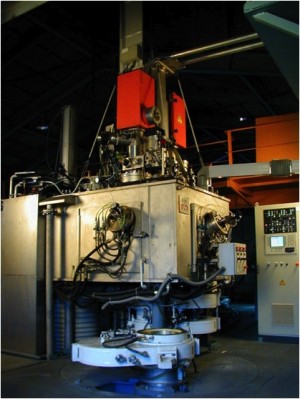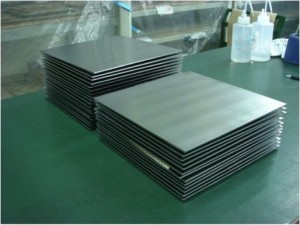The International Linear Collider will need about 16,000 superconducting radiofrequency cavities, devices that accelerate electrons and their antiparticles, positrons, along microwaves to near speed of light. These cavities are made out of pure niobium, which means the ILC community needs 500 tonnes of high-purity niobium processed into nice, smooth sheets.
In the industrial session held prior to the Global Design Effort baseline technical review meeting at KEK, Japanese company Tokyo Denkai made a presentation to ILC scientists on their capability and method for producing niobium sheets for superconducting cavities.
To process the nine-cell cavities, the niobium first needs to be melted, heated to very high temperatures to remove impurities. The refined niobium is then processed into square sheets about 30 centimetres on a side. The sheets are shaped into half-cells at the cavity fabrication facilities. The half-cells are eventually welded together to form nine-cell structures.
Tokyo Denkai is primarily in the business of refining and producing the mill products of tantalum and niobium. About 80 percent of their business is tantalum processing. The remainder comes from processing niobium, niobium alloys and other metal materials.
Founded in 1932 as Takeuchi Shoten (which means store or shop), Tokyo Denkai began as a metal extractor, extracting tin metal from recycled food cans. In 1959, current president Koichi Takeuchi started the tantalum business, and nine years later, entered into the niobium business. Tokyo Denkai installed two high-power electron beam melting furnaces during this period, an essential facility for producing high-purity niobium.
Their close relationship with accelerator laboratories began in 1985, when Tokyo Denkai won a bid for processing niobium sheets for superconducting cavities for KEK’s TRISTAN accelerator. In 1993, they took themselves out of the recycling business, concentrating all their resources on tantalum and niobium.
In 1996, Tokyo Denkai started to supply high-purity niobium sheets to DESY laboratory in Germany for their TESLA test facility. They also supplied one-third of the material needed to produce superconducting cavities for the Spallation Neutron Source at Oak Ridge National Laboratory, US. They continued investing in melting furnaces, and by 2010, were nicely equipped with seven furnaces. (They retired one in 2010, replacing it with a new furnace one month later.)
With this great capacity for pure-niobium sheet production, Tokyo Denkai won the bid for the European XFEL, providing it with half of its superconducting half-cell material. “For that contract, we are going to supply 5,886 sheets of high-purity niobium. All the shipments are on time so far, and production is ahead of schedule,” said Hiroaki Umezawa from Tokyo Denkai. The company later received an additional order of 1,484 sheets for European XFEL GmbH.
To deal with the large orders from Europe, Tokyo Denkai installed two new types of machine to reduce the production time: the automatic buffing machine and automatic etching machine. Before acquiring the machines, all the etching work had been done manually by the workers. Since this type of work uses chemical solutions and requires handling metal dust, the work came with substantial risks. “It was risky, and workers needed to work under tough environmental conditions,” said Umezawa. Because the shops were not equipped with air conditioners, windows and doors were left open all the time to keep the room ventilated. In winter, room temperatures plummeted to zero and in the summer, rose to 40 degrees Celsius. Thanks to the new machines, these tough jobs are now being done automatically. “I would like to thank DESY for the large order,” Umezawa said. “It was good motivation for obtaining those new machines.”
Tokyo Denkai estimates their capacity to produce niobium sheets for the ILC based on the capacity of its newly outfitted shop and experience from supplying a large batch to XFEL: “We can produce 4,000 sheets per year,” said Umezawa. Estimating the production period as seven years, they can supply 28,000 sheets for the ILC, which covers almost 10 percent of the total sheets needed. “However,” he added, “we can increase the capacity if necessary.”
Tokyo Denkai now has seven working furnaces, though only two of them are currently used for niobium processing. “If we use six of the furnaces to melt the niobium, the production capacity will be tripled, in principle,” said Koichi Takeuchi, company president. He also said that they are upgrading the furnaces to increase productivity.
Tokyo Denkai concluded that increased production can take place only under two conditions. One is of course a stable electric supply. The other essential element, said Takeuchi, is “the continuous supply of sufficient raw niobium material. We do need to consider reserving a large amount of raw material for the project as big as the ILC,” Takeuchi said. “Otherwise, it becomes impossible to supply stably if the price rises drastically.” This might be an issue for the ILC project to consider. Scientists will continue to communicate closely in advance with industries about similar issues to bring the realisation of the ILC one step further.



Recent Comments